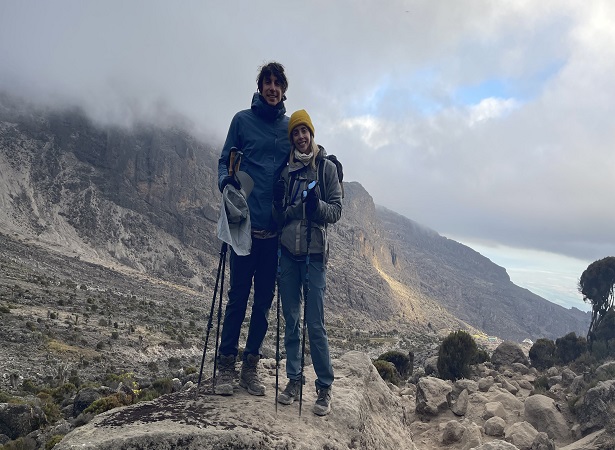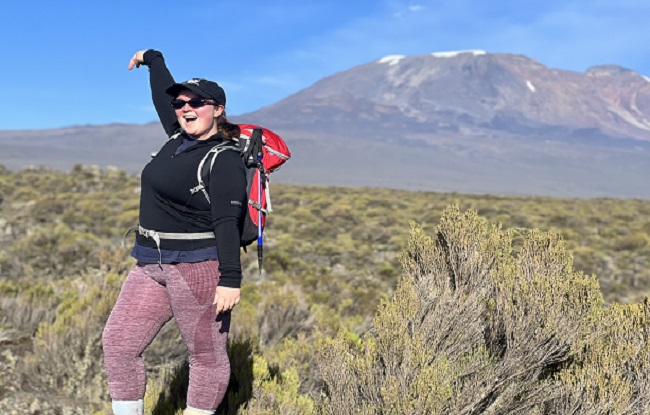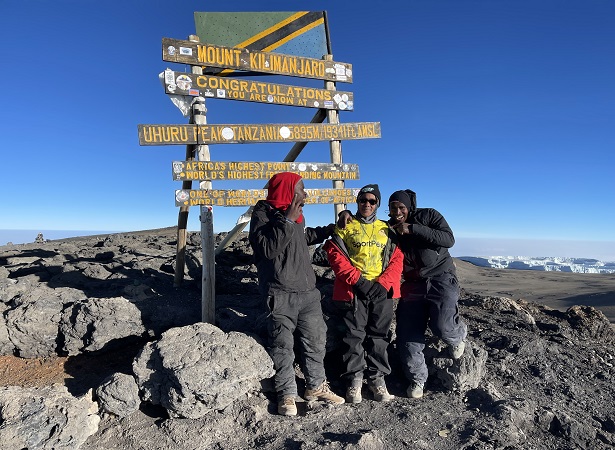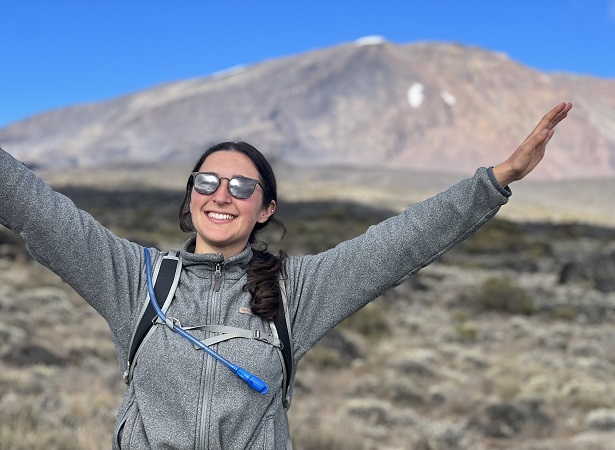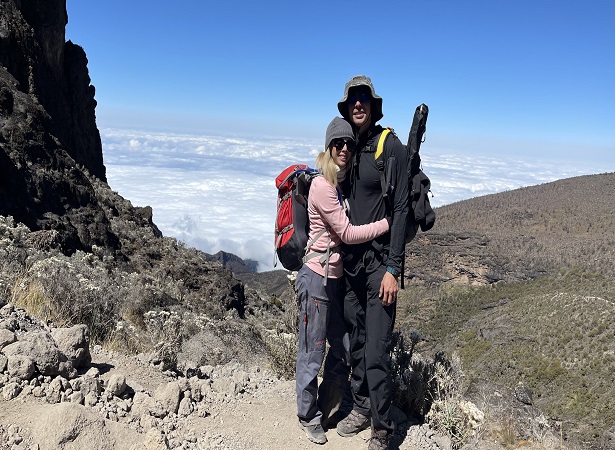6 Days Rongai Route
The Rongai route is the only route that approaches Kilimanjaro from the north, close to the Kenyan border. Though gaining popularity amongst climbers, Rongai has low traffic. It is the preferred route for those looking for an alternative to the crowded Marangu route, for those who would like a more remote hike, and for those who are climbing during the rainy season (the north side receives less precipitation).
| Detailed Itinerary Rongai – 6 days | |
DAY 1 | After completing the necessary registration formalities at Marangu National Park gate, we transfer to Rongai. The climb begins from Nale Moru (1,950 m) on a small path that winds through fields of maize and potatoes before entering pine forest. The track then starts to climb consistently, but gently through attractive forest that shelters a variety of wildlife, including the beautiful Kilimanjaro Colobus monkey. These monkeys are black with a long ‘cape’ of white hair and a flowing white tail. The forest begins to thin out and the first camp, Rongai One, is at the edge of the moorland zone (2,600 m) with extensive views over the Kenyan plains. [3-4 hours walking] |
DAY 2 | The morning walk is a steady ascent up to the ‘Second Cave’ (3,450 m) with superb views of Kibo and the Eastern icefields on the crater rim. After lunch, we leave the main trail and strike out across the moorland on a smaller path towards the jagged peaks of Mawenzi. Kikelewa campsite is in a sheltered valley with giant senecios near Kikelewa Caves (3,600 m) [6-7 hours walking] |
DAY 3 | A short but steep climb is rewarded by superb all round views and a tangible sense of wilderness. We leave vegetation behind shortly before reaching the next camp at Mawenzi Tarn (4,330 m), spectacularly situated in a cirque directly beneath the towering spires of Mawenzi. The afternoon will be free to rest or explore the surrounding area as an aid to acclimatisation. [3-4 hours walking] |
DAY 4 | We cross the lunar desert of the ‘Saddle’ between Mawenzi and Kibo to reach Kibo campsite (4,700 m) at the bottom of the Kibo crater wall. The remainder of the day is spent resting in preparation for the final ascent before a very early night! [5-6 hours walking] |
DAY 5 | We will start the final, and by far the steepest and most demanding, part of the climb by torchlight around 1 a.m. We plod very slowly in the darkness on a switchback trail through loose volcanic scree to reach the crater rim at Gillman’s Point (5,685 m) We will rest there for a short time to enjoy the spectacular sunrise over Mawenzi. Those who are still feeling strong can make the three hour round trip to Uhuru Peak (5,896 m), passing close to the spectacular glaciers and ice cliffs that still occupy most of the summit area. The descent to Kibo (4,700 m) is surprisingly fast and, after some refreshment, we continue the descent to reach Horombo Camp (3,720 m). [11-15 hours walking] |
DAY 6 | A steady descent takes us down through moorland to Mandara Hut (2,700m), the first stopping place at the Marangu route. We then continue descending through lovely lush forest on a good path to the National Park gate at Marangu (1,830 m). [5-6 hours walking] |
The Rongai route is the only route that approaches Kilimanjaro from the north, close to the Kenyan border. Though gaining popularity amongst climbers, Rongai has low traffic. It is the preferred route for those looking for an alternative to the crowded Marangu route, for those who would like a more remote hike, and for those who are climbing during the rainy season (the north side receives less precipitation).
The minimum number of days required for this route is six days, and seven days are recommended.
Although the scenery is not as varied as the western routes, Rongai makes up for this by passing through true wilderness areas for days before joining the Marangu route at Kibo camp. This route descends down the Marangu route. Rongai is a moderately difficult route, and is highly recommended, especially for those with less backpacking experience.
Price Per Person in US Dollars
- $2,600 per person when Solo trekker
- $2,400 per person when 2 people treks together
- $2,300 per person when 3 people treks together
- $2,200 per person when 4 people treks together
- $2,100 per person when 5 people treks together
- $2,000 per person when 6+ people treks together
What’s Includes
- Transport from/to park gate & airport transfer
- Pre and post climb accommodation (B&B) in Moshi
- Park, camping & rescue fees
- Mountain tent & mattress
- Professional English speaking guide(s), porters & chef
- breakfasts, lunches and dinners
- Water; tea and coffee with meals
What’s not included
- Flights
- Lunch & dinner in Moshi
- Travel insurance
- Visa and passport fees
- Increases in park fees where applicable
- Personal equipment
- Sleeping bag
- Tips for guide(s), porters & cook
- Soda and Alcoholic beverage
Book the Tour
Related Kilimanjaro Tours
- From: $.3200
- From: $.2400
- From: $.2,600
- From: $.2800
- From: $.3,200
- From: $.2000
- From: $.2,500
- From: $.2700
- From: $.2800
- From: $.2300
- From: $.1300
Mount Kilimanjaro Climbing Routes
When it comes to embarking on a Kilimanjaro climbing expedition, choosing the right route is crucial for a successful and enjoyable experience. With several routes to choose from, each with its own characteristics and challenges, it’s important to consider various factors before making your decision. There are various routes to choose from when climbing Mount Kilimanjaro, each offering different landscapes, challenges, and experiences.
The Marangu Route is one of the most popular routes for those who want to trek to the top of Mount Kilimanjaro. Also known as the “Coca-Cola Route,” it is the only route that offers hut accommodations and is considered the easiest route. However, this also means that it can be crowded during peak season.
The Machame Route is also known as the “Whiskey Route” and is the most popular trekking route in Tanzania. It is a challenging route but also the most scenic due to the panoramic views of the Shira Plateau and the Western Breach. With its rocky terrain, trekking poles are highly recommended.
Rongai route ascends Mount Kilimanjaro from the north-eastern side of the mountain, along the border between Tanzania and Kenya. The rongai route retains a sense of unspoiled wilderness. The Rongai route is the only route that approaches Kilimanjaro from the north.
The Lemosho Route is the best way to climb Kilimanjaro and experience the breathtaking beauty of the mountain. With its numerous advantages, including scenic views, diverse flora and fauna, and a higher success rate, you can be sure of an unforgettable experience.
Kilimanjaro’s Northern Circuit Route is a remote and beautiful trail, but it’s a challenging trek that requires careful planning and preparation. It is the longest route on Kilimanjaro. It offers amazing scenery, excellent acclimatization, and a quiet trek. This is the reasons we love this Kilimanjaro route!
Proper acclimatization and physical preparation are crucial to reach the summit of Mount Kilimanjaro via the challenging Umbwe Route. The route includes several acclimatization days, and proper preparation will enable climbers to tackle the final ascent towards Stella Point.
The route approaches Mount Kilimanjaro from the west, beginning with a long drive from Moshi to Shira Ridge. The vehicle bypasses the rain forest zone and the hiking trail begins on Shira Ridge. The Shira route crosses the entire Shira Plateau from west to east in a pleasant, relatively flat hike.
Kilimanjaro mountain bike trail itinerary is the new service for summiting Mt Kilimanjaro for active and adventure lovers. The Kilema route is the only route that you can reach to the summit by mountain bike. Our experienced guides have done a sufficient number of successful bike trails to the summit.
Mount Meru(4,566 m) is an active stratovolcano and forms the centrepiece of Arusha National Park in Tanzania. Although the mountain is not as high as Kilimanjaro, it is just as challenging. Known for its beautiful green surroundings and abundant wildlife, Mount Meru is the second highest in Tanzania.
Frequent Asked Questions for Kilimanjaro Climbing
There are six initial approach routes, counter-clockwise from west to east:
1. Lemosho Glades – starting from a remote trailhead and ascending through forest, and heather over two days to reach the western edge of the great Shira plateau. This route continues up either the Northern Circuit, Western Breach or the Machame/Southern Circuit route. Done via the Southern Circuit (most common), it’s the longest distance route to choose on Kilimanjaro. It’s best done 7 or more days.
2. Shira /Morum Barrier – This route starts high (over 12,000’ / 3,500m) but on longer climbs offers the chance of easy/gentle hiking from the start of the climb, as well as avoiding other tourists, especially when choosing the remote northern circuit route. Although a start from Morum Barrier Gate offers the choice to continue on the Southern Circuit, Northern Circuit or Western Breach, it’s best done via the Northern circuit in 8 days (as per our 8-day group trek option). We prefer this route over all others, for its’ wilderness character and low foot-traffic.
3. Machame (Whiskey Route) – by far the most popular route and busiest route overall, usually done in 6 or 7 days via southern circuit and finally ascending to the summit via the east facing Mweka (Barafu Camp) route to the crater rim at Stella Point. It’s also quite pretty and rugged. Best done in 7 days. Very difficult to do in 6 days.
4. Umbwe – The shortest and most direct way to Kilimanjaro’s summit, and this is the most challenging both in terms of terrain and grade. This route is best done via the Western Breach, in 6 or 7 days, but can continue on the Machame/Southern circuit route too.
5. Marangu (Coca-Cola Route) – the original hut route starting at the southeast and passing through thick forest, heather and moorland before crossing the saddle between Mawenzi and Kibo, then up to Gillman’s point before skirting around the south crater rim to Uhuru Peak. Pre-booking and deposits are required on this route (to reserve the huts). From 5+ days, best done in 6 days.
6. Rongai – An approach from the dry northeast (Kenya side), up to the flanks for Mawenzi (the most easterly of Kilimanjaro’s three volcanoes) then on into the great expanse of barren saddle between Mawenzi and Kibo, and finally up to the summit via the Marangu Route. From 5+ days, but best done in 6 or 7 days. The descent route on Rongai is the Marangu Route, which makes for a longer last day than other camping routes.
There is a circuit of routes traversing the Kibo massif in the alpine desert (ranging from about 3,500 to 4,000 m), and from this circuit on upwards there are only three summit route choices.
The Northern Circuit is by far the least used route on Kilimanjaro, and is home to the true wilderness on Kilimanjaro.
The Southern Circuit is essentially the continuation of the popular Machame Route following the east facing Mweka (Barafu Camp) route to the crater rim at Stella Point. This route to the summit receives more than 80% of all summit foot-traffic. Most of the rest of the summit-goers pass via the Marangu Route via Gillman’s point before skirting around the south crater rim to Uhuru Peak.
The Western Breach is the third and last summit route, and gets a tiny percentage of the summit foot traffic, as it’s a steep scramble from camp at 4,900 m (Arrow Glacier Camp) to the crater rim at 5,900m, and is a true alpine-adventure style scrambling route, which includes rock fall risk. We’ve imposed our own restrictions on this route, in order to ensure the group is relatively homogenous and have prior experience with this type of terrain. We provide mountaineering helmets for all participants who ascend the Western Breach.
The best times of year to climb Kilimanjaro for the weather (avoiding rain) are January to early March and July to mid-October. There’s a long, dry winter and a green season with two rainy periods at each end. December, January, February and March are the warmest months, with clear mornings and evenings, and clouds building during the day that occlude the summit in the early afternoon hours. The predictable patterns of weather make it a good time to climb.
The main rainy season lasts from the beginning of April to early June. At this time, dense cloud formations massed over the mountain reduce visibility, and you can expect frequent snowstorms on the summit and heavy rains on the lower slopes.
The longest and driest season runs from mid-June to mid-October. During this time it can be very cold at night. During Kilimanjaro’s “winter,” there is a persistent dripping belt of clouds girdling the whole mountain above the forests and the moorland contour, leaving the summit and a few other distant peaks poking through. Above the clouds, it is usually clear and dry, and this is one of the best times to plan the trek.
In late October, the clouds finally give way to rain, and until the middle of December, the mountain is often shrouded in heavy clouds, with persistent showers from base to summit.
The best months to climb Kilimanjaro are January, February, July, August and September.
Avoid climbing during the April-May heavy rain season, and November (the short rains) if you can. During these times, in order to stay out of the ‘crowds’, it’s best to avoid the Machame Route, and on any route; avoid starting your climb on a Saturday or Sunday (the majority of groups start on these days). Regarding climbing on a full moon, we recommend arranging the summit attempt three to five days AFTER the full moon, for optimal moonlighting the summit trail during the night.



